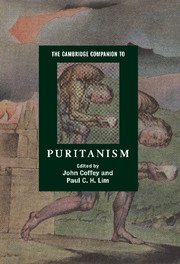Book contents
- Frontmatter
- Introduction
- Part I: English Puritanism
- Part II: Beyond England
- Part III: Major Themes
- 11 Practical divinity and spirituality
- 12 Puritan polemical divinity and doctrinal controversy
- 13 Puritans and the Church of England: historiography and ecclesiology
- 14 Radical Puritanism, c. 1558-1660
- 15 Puritan millenarianism in old and New England
- 16 The godly and popular culture
- 17 Puritanism and gender
- 18 Puritanism and literature
- Part IV: Puritanism and posterity
- Index
15 - Puritan millenarianism in old and New England
from Part III: - Major Themes
Published online by Cambridge University Press: 28 November 2008
- Frontmatter
- Introduction
- Part I: English Puritanism
- Part II: Beyond England
- Part III: Major Themes
- 11 Practical divinity and spirituality
- 12 Puritan polemical divinity and doctrinal controversy
- 13 Puritans and the Church of England: historiography and ecclesiology
- 14 Radical Puritanism, c. 1558-1660
- 15 Puritan millenarianism in old and New England
- 16 The godly and popular culture
- 17 Puritanism and gender
- 18 Puritanism and literature
- Part IV: Puritanism and posterity
- Index
Summary
In 1629 William Twisse sent an intriguing letter to his close friend, the Cambridge divine Joseph Mede. Twisse wrote, “I seem to discern a providence of God in causing the opinion of a Thousand years Regnum Sanctorum to be blasted as an Error by the censure passed upon the Chiliasts, to take men from fixing their thoughts too much on that in those days, when the accomplishment was so far removed; but with purpose to revive it in a more seasonable time, when Antichrist's kingdom should draw near to an end.” Twisse was recounting the history of millenarianism, in which the early church condemned the patristic form of this doctrine, known as chiliasm. Not only did the early church censure chiliasm, but by the seventeenth century all three major branches of the Protestant church condemned this eschatological position in their confessional standards. The Lutheran Augsburg Confession of 1530, the English Forty-Two Articles of Religion of 1552 and the Reformed Second Helvetic Confession of 1566 unanimously repudiated millenarianism. Yet, Twisse's letter indicated a revival of millenarian interest during the more 'seasonable time' of his day. By the seventeenth century millenarianism was acceptable and popular amongst many Puritans. This introduces a puzzling historical question: how do we explain the rebirth and popularity of such a controversial doctrine amongst seventeenth-century Puritans? In addition, what is the precise relation between millenarianism and Puritanism?
- Type
- Chapter
- Information
- The Cambridge Companion to Puritanism , pp. 259 - 276Publisher: Cambridge University PressPrint publication year: 2008
- 5
- Cited by



